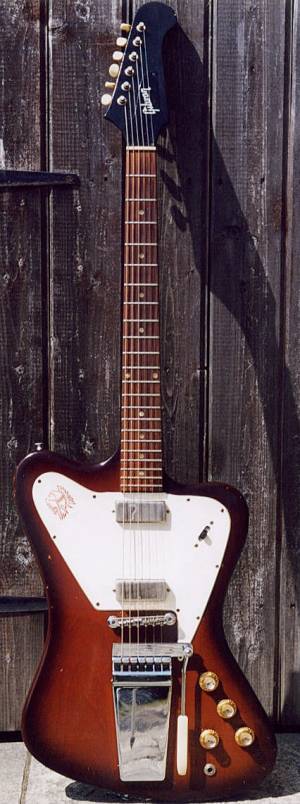
Here's another example from Gibson's re-modelled Firebird range of late 1965. The marketing disaster of the original "reverse"-style guitars (see Previous Picks) provoked a radical re-think in design. The strategy was simple: produce an instrument to compete directly with Fender that would be cheap to manufacture, yet retaining the reputation for quality associated with the Firebird marque. Quite how Gibson imagined they were going to make a killing with this ungainly-looking beast is anybody's guess; however, the new guitars were lighter, comfortably balanced, easier to play and - contrary to collectors' folklore - had a better sound than their doomed predecessors.
The designated model numbers I, III, V & VII were retained, but their appointments altered slightly. To start with, all models consisted of the same 1¼"-thick slab of mahogany for the body, and all were routed for three pickups. All used the same separate glued-in one-piece mahogany neck and rosewood fingerboard, with pearl dot fret markers and no binding. Gone were the heavy banjo-style pegs and two-tier head-stock - the tuners were cheap, six-on-a-strip Klusons, some with plastic buttons, others nickel-plated metal (except VII, which was gold-plated), the bird-shaped head now flat and facing right. Cheaper still was a new sliding selector switch for the pickups, another rotten component that would be replaced by a standard toggle by 1967.
Firebirds I & III were supplied with 2- and 3-P.90 single-coil pickups respectively, "bone handle" SG-style tremolo units and Gibson's TPBR-8513 ridged bridge. Firebirds V & VII sported 2 nickel-plated or 3 gold-plated mini-humbuckers respectively, with leaf-and-lyre engraved Maestro DeLuxe tremolos and a Tune-O-Matic bridge. Standard finish was tobacco sunburst, though custom colours could be ordered for an extra 15 bucks - those were the days!
The retail aspect was a tad bizarre; Firebirds I & V both offered two pickups and a tremolo system, yet there was a $100 difference in price. Similarly, $150 separated Firebirds III & VII, the latter's gold plating apparently hiking up the cost by another $50. Just the same, the new models were produced in fairly large quantities, albeit riddled with quality control issues such as tuning instability, fragile head-stocks, and that wretched Carter jack socket. The illustrious McCarty era at Gibson was drawing to a close, the first casualties of the regime change clearly being the instruments themselves…
Another quirk of the period was the company's decision to cease nickel-plating their standard metal parts in favour of chromium, with many Firebirds and SG's supplied with mis-matched metal parts during this cross-over period. Though identical in appearance when new, in time nickel tarnishes where chrome remains resolutely shiny forever. This guitar reveals an interesting mixture of metal bits: nickel-plated pickup covers and bridge, chrome plated tremolo components and bridge adjuster wheels. And standard gold-coloured plastic knobs!
Worse still, it left the factory with its trapeze tail-piece about 4° out-of-true, requiring some basic corrective surgery by yours truly and a trusty power drill. Having been poorly stored in an Arkansas loft for a number of years, the lacquer finish has checked considerably and the celluloid pick-guard has buckled and shrunk by about ¼" from the edge. Fortunately, the previous owner noticed in time and removed the screws before they tore holes in the plastic, a common sight on many vintage Firebirds. But hey - enough of my yakkin'…
Despite its distressed appearance, this is the best Firebird I've ever played. Certainly it's the best all-round rock'n'roll guitar I own, and witnessing the post-Nirvana grunge-fest guitar sounds so popular today, I'm convinced Firebird V is a sleeping giant, possibly Gibson's best-kept secret. A pox on all those players who ripped out these pickups in the 70's - the mini-hums are bright and powerful, with the super-light mahogany body adding that unmistakable tone only a Gibson can deliver. This is a magnificent guitar, and the beautiful part is that it's just 22 numbers away from my Firebird III! Separated at birth, to be re-united 37 years later at the Old Birds' rest home…